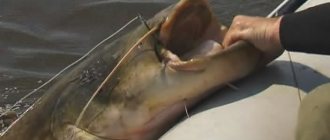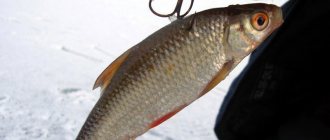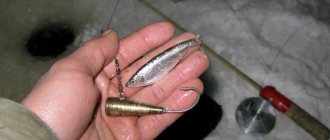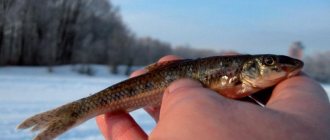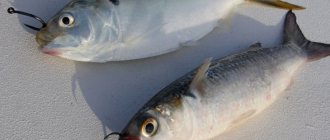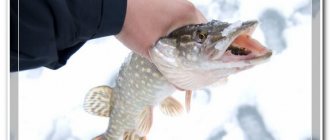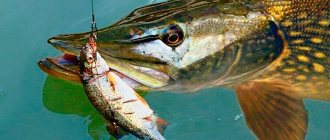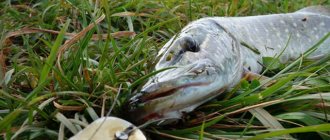Yuri 05.10.2020 1068
Most fishermen love to hunt pike, and I am no exception: since this predator is incredibly cunning, it is really interesting to fish for it. The excitement is mainly associated with the complexity of the process, which is due to the excessive caution of the fish and powerful resistance in the process of attacking the gear. That is why there are now a colossal number of pike fishing methods. Recently, catching pike with a trap has been gaining popularity.
This technique appeared back in the 80s, but since then a wide variety of traps have appeared on the market, even homemade models. I experimented with different designs, even made the devices myself, but this option is only suitable for those who have a lot of free time. Therefore, now I prefer ready-made purchased options; they can be ordered in the online store for fishermen.
Therefore, I will tell you in detail about what kind of device this is, what it is needed for and how to use it.
Winter "hunt"
There are several nuances to catching pike with traps in winter, which every experienced fisherman should know about. First you need to drill a hole. After this, the trap should be lowered into the hole. It is better to tie the other end of the fishing line to a large stick, and I usually place it across the hole.
In winter, you come across truly trophy specimens. But it is not so easy to interest them; it is better to use a fairly mobile live bait that is capable of creating significant fluctuations in the water. Since during this period of time the predator is not very active.
Techniques for attaching live bait to a pike trap
Back attachment
Several options for attaching live bait to a hook deserve attention, but the most common method is considered to be the method of attaching it behind the back. Moreover, this must be done carefully enough so as not to damage the back muscles, otherwise the fish will not behave actively and will quickly stop moving under water at all. As a rule, with this type of bait a single hook is used, although some experienced fishermen attach live bait to double or even triple hooks.
Attachment for gills
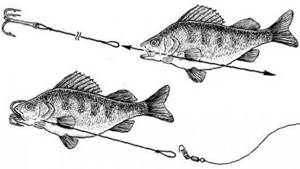
This type of bait attachment is somewhat complex, although it is safer for live bait and the possibility of harming it is almost minimal. To do this you will need a double hook rig. The bait technique boils down to the fact that the leash is threaded through the gills and brought out at the level of the fish’s mouth. The hook of the rig is threaded through the loop so that the loop is on top of the hook. After this, the loop is tightened until the hook is next to the baitfish’s mouth.
This option of using live bait also has its drawbacks. But, if you use a soft leash, then there will be no problems and the baitfish will remain active in the water column for a long time.
How to properly place live bait on a hook.
Tail attachment
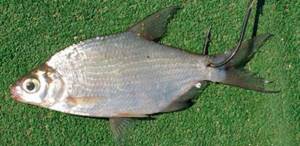
The tail attachment also has its advantages, since it does not injure the live bait at all. To do this, it is better to take a rubber band or just a piece of fishing line. Live bait is not injured at all and behaves much more actively than with other methods of baiting. The fact is that he will try to free himself from this element, which will explain his increased activity. Despite this, the option does not provide 100% confidence in capturing the predator. This is due to the fact that pike swallows its prey from the head, and not from the tail. In this regard, there are many idle bites.
Summer fishing
If you are interested in catching pike with a trap in the summer, then keep in mind that in the hot season you should use the trap in shallow water or under thickets. The trap should be loaded with live bait and attached to a branch on a tree or to a strong stick fixed to the surface.
- Important! The trap should be tied well, as the fish can drag it along with it.
After setting the traps, I make sure to check them regularly. If necessary, I change live bait. The bait must be alive and mobile, otherwise such a delicacy simply will not interest the predator. Moreover, the pike rarely uses its sense of smell and vision; it usually uses its sides, with which it perfectly senses all the vibrations in the water.
Installing a trap on site
How to set traps for pike? It seems optimal to install this device as close to the bottom as possible. It is important that it does not work when directly lowered to the bottom. Since the favorite habitat of pike is snags and dense underwater vegetation, this is where it is advisable to start hunting. If we talk about bait, then when using live bait, it is necessary that it stay under water as long as possible, showing its activity on the hook (placed on the lower prong of the trap). The pike takes the bait across. As soon as it captures the bait, the spring will immediately work, causing the trap to slam shut. When using and installing this item, the fisherman needs to be extremely careful, since even an awkward movement can damage his fingers.
So, we found out that a trap for catching pike can be used in hard-to-reach places, which, for example, include snags. In this he has no equal if the catch obtained from a trap is compared with the catch that occurs on a spinning rod. Thanks to the use of a long cable, pike fishing is possible at a fairly decent depth.
Description of the technique
Above I talked about the features of seasonal fishing, but before you buy a structure, you should carefully inspect it. The product must be made of durable, high-quality raw materials.
When a fish bites a live bait on a pike trap, a mechanism is triggered.
At the moment of activation, only the lower row of teeth reacts, injuring the prey. The guard is attached in a special way to the top of the structure, and inside there is a small hole through which the fishing line mount passes. Yes, this mechanism also contains a spring to create pressure.
In general, the device is not as simple as it might seem at first glance. But it’s not easy to make it yourself; you need to try it at least several times to get a real, functioning trap.
- Interesting! There are several models of traps, but there are even products that weigh more than 20 kg.
The trap allows the fisherman to catch a predator of any size or weight. But to achieve the result, you should install it:
- in reed thickets;
- on the washed-out shore.
In other places of the reservoir, hunting will not bring you the desired result.
With the help of a trap you can always catch a predator, regardless of the season.
Setting up a trap for catching pike
By design, a pike trap is made of two flat metal rods with pointed ends. There is also a coil spring present here. In order for this item to be in the cocked position, a fishing line or cord is tied to the guard. Of course, a trap for catching pike is selected based on the size of pike the fisherman plans to catch. If you try to construct a trap for catching a given predator with your own hands, then this is a rather labor-intensive task that requires certain skills from a person.
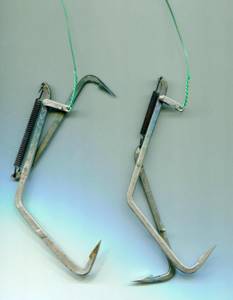
How to attach live bait to a pike trap? Trap fishing using live bait is a passive form of fishing. At the same time, the active participation of a person in this process is not required, which is very good if the fisherman is a novice. The main thing is to correctly and securely fix the live bait on the trap so that it does not fly off or is easily removed by the fish from the hook. So, if you take a perch (about 10 cm in length), it is best to hook it behind the back, or through the lower jaw. Thanks to this, catching small items is excluded here. The mechanism of such a device works properly; after the pike has swallowed the bait, the tip of the trap pierces its jaw, since, due to its touch to it, it presses on the lower prong of the trap, which is promptly triggered.
You can purchase options that will be made of either brass or stainless steel. Only on a working device, the rods with sharpened ends present here should spring back in time, having done their job. The main thing is to configure the design correctly. This must be done for preventive purposes so that the mechanism available here does not work at the wrong time. The upper tooth on the trap is securely hinged to the lower tooth, however, only the lower one moves in two directions. The guard with a hook is located in the upper part. The force with which the trap will ultimately slam when a predator is caught directly depends on the spring available here. There is no need to use any separate hooks, since a completely different fishing technique is used.
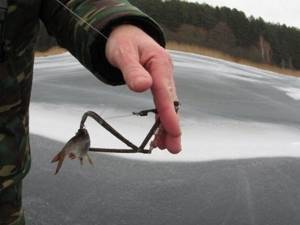
Thus, modern pike traps are quite easy to use. Before you start using it directly, you need to attach live bait to the pointed prong. For greater reliability, live bait can be tied with wire. All parts on the trap must have anti-corrosion treatment, since this circumstance acts as a guarantee that the service life of this device will increase. In addition, its moving mechanisms must be well lubricated.
Tags
Carp Buffalo Spring Vobla Asp Winter Crucian Rudd Summer Fishing baits Lower Volga Perch Autumn Fisherman's reminder Lures Bite forecast Fishing in Astrakhan Fishing baits Fishing tackle Fishing secrets Catfish Fishing methods Pike perch Catch Pike
Description of the gear
The trap is a hunting trap optimized for use underwater. This trap is made of brass or durable stainless steel 3 millimeters thick. The design is reliable and simple, consisting of jagged teeth, a rod and two hinges. The trap is driven by a powerful spiral spring , which is activated when the guard or latch is activated.
The weight and size of such devices may vary depending on the live bait used and the size of the pike living in the reservoirs. On sale you can find both small traps and large models that are larger in size and have lower sensitivity, which allows you to use live bait weighing 300-500 grams as bait.
Passage traps
With each hunting season, this type of trap is becoming increasingly popular, due to their high efficiency, as well as the introduction of a legislative ban on the use of trace traps. Unlike the latter, walk-through traps do not have a base or massive arches - all parts here are made of durable steel wire. They got their name because of the specifics of their use: they are installed at the exits of burrows, on animal trails, and are triggered when an animal passes through the frame and touches the guard. Under the action of springs, the metal frames strike the animal’s body in the area of the neck, sternum or lower spine. As a result, the animal dies almost instantly, without experiencing unnecessary suffering, which is why these traps are called humane.
In addition, walk-through self-catchers have the following features and advantages:
- Minimum catches and low probability of wounded animals.
- The power of multi-turn wire springs is higher than that of those made of sheet metal.
- Possibility of installation on the ground, snow and ice, under water.
- The animal's skin is not damaged, which is of great importance in the fur trade.
- Simplicity and reliability of design.
The size range of pass-through self-catchers is quite extensive: from compact ones designed for catching moles and gophers, to fairly large models used for beaver hunting. In the Trophy online store you can purchase humane traps of the following modifications:
- KP-125N
– used in fishing for sable and mink, marten and ferret, squirrel, muskrat; - KP-140N
is larger and more powerful than KP-125. Also designed for catching small-sized furs that can pass through a frame with an edge length of 140 mm. - KP-250N
- designed for catching such relatively large animals as beaver and otter, badger and raccoon dog, arctic fox and even lynx. - KP-320
is the largest migratory fishing rod, used for catching beaver and lynx.
Advantages and disadvantages of using a trap
Benefits of use:
- The first advantage of using the device is its mining ability. If the pike is hunting and the described trap is located where this happens, then the catch will be plentiful.
- Another advantage of using it is that you can catch fish without restrictions on weight and length, unless the fishing line is too thin.
- Also a positive factor is the all-weather, all-season use of the self-catcher.
- The person who set the trap is not tied to the place of fishing. This is a plus, because the fisherman himself chooses the time to check the trap.
- Another advantage is low cost. For 2-3 hundred rubles, 2-3 self-catching devices are purchased.
Disadvantages of use:
- The first drawback is the lack of proper excitement due to the lack of struggle with a cunning, cautious predator, the transformation of sport fishing into work, a type of extraction of food resources and money.
- The second drawback is the ban on the use of self-catching devices in most of Western and Central Russia. We have to take this issue into account and clarify whether it is possible to use it before installation.
- The obvious disadvantage is the death of young animals. It is no longer possible to release captured squinting pups, because triggering the trap leads to lethal consequences for the victim caught there.
We invite you to read: Fishing for carp on a donk: production, fishing tactics in spring, autumn or summer
DIY pike trap
To make a trap at home, you will need some special tools that every man has:
- pliers;
- table with a vice or workbench;
- file;
- drill and metal drills;
- screwdrivers, wrenches.
Before actually making a pike trap with your own hands, you need to select drawings or have a ready-made device as an example. You can also use it for a drawing or find a ready-made drawing online. Materials you will need:
- metal rods, welding electrodes from which it is necessary to remove the coating, or thick knitting needles are suitable;
- for the role of a guard, a piece of high-rigidity steel wire will do;
- spring, it is better to choose from stainless steel;
- bolts, nuts, washers.

By following all the instructions, you can make the tackle yourself
The first step is to make “jaws” on the metal rods - sharpen the ends, cut out the notches. The easiest way to do this is with a file. The sides with hooks must be bent according to the selected template. And prepare the other sides for attaching a bolt or rivet. To do this, you need to make suitable sized eyes using a drill. Attach a guard to the upper jaw, and weld a small metal plate to the lower jaw with a hole into which the latch will be attached.
Insert a bolt and nut into the prepared eyes and fasten the two rods together. It is important not to fasten it tightly, but to leave a little free movement so that the “jaws” can move. Attach the spring from the back in a convenient way. And in the upper part of the fixed rod, drill a hole for the leash and carabiner, which will be used to equip the finished product. These step-by-step instructions will allow you to make a homemade version of a pike trap.
The principle of operation of the trap
A pike trap works like when fishing with live bait, only the mechanism works automatically, without human intervention, as soon as the predator grabs the prey. The principle of operation of such structures is the same - the activation of an alert mechanism, the capture of the target by the approaching working parts, biting into the victim, securely holding within the radius of the length of the fishing line (chain, leash) attached to a stationary object (stick, pole, bracket).
The working parts of this trap are held in the “alert” position by a corresponding spring, which is released after a bite. A steel mechanism with a strong spring is “able” to catch a predator weighing more than 5 kg.
Threading live bait by the tail
All previous methods have a significant drawback; they injure live bait and make it less effective. Anglers have a rather interesting method of baiting bait by the tail, which is called tricky. It does not cause damage and allows the fish to remain alive for a long time.
In this case, an elastic band is put on the tail; you can also wind fishing line or thread. Then a single hook is threaded through. The bait tries to throw off a foreign object and thus shows good activity.
This option is not suitable for catching pike , since it can easily bite the fishing line, is very attentive and careful, and rarely swallows prey from the tail.
